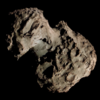15P/Finlay
 | |
| Discovery | |
|---|---|
| Discovered by | William Henry Finlay |
| Discovery date | September 26, 1886 |
| Designations | |
| 1886 S1; 1886 VII; 1886e; 1893 K1; 1893 III; 1893a; 1906 V; 1906d; 1919 II; 1919d; 1926 V; 1926d; 1953 VII; 1953i; 1960 VIII; 1960d; 1967 IX; 1967g; 1974 X; 1974d; 1981 XII; 1981e; 1988 IX; 1988f | |
| Orbital characteristics | |
| Epoch | 2014-Dec-09 (JD2457000.5) |
| Aphelion | 6.019AU |
| Perihelion | 0.976 AU |
| Semi-major axis | 3.488 AU |
| Eccentricity | 0.7202 |
| Orbital period | 6.51a |
| Inclination | 6.799° |
| Last perihelion | July 13, 2021[1] December 27, 2014[1][2] June 22, 2008 |
| Next perihelion | 2028-Feb-09[3] 2034-Sep-08 2041-Apr-03 2047-Oct-25 2054-May-02 2060-Oct-03[4] |
| EarthMOID | 0.009 AU (1.3 million km)[5] |
| JupiterMOID | 0.16 AU (24 million km)[5] |
| Physical characteristics | |
| Dimensions | 1.8 km (uncertain)[6] |
Comet Finlayis aperiodic cometwith anorbital periodof 6 years discovered byWilliam Henry Finlay(Royal Observatory,Cape of Good Hope,South Africa) on September 26, 1886. The nextperihelionpassage is July 13, 2021 when the comet will have asolar elongationof 54 degrees at approximatelyapparent magnitude10.[7]It last came to perihelion on December 27, 2014,[2]at around magnitude 10.[7]Of thenumbered periodic comets,the orbit of 15P/Finlay has one of the smallestminimum orbit intersection distanceswith the orbit of Earth (E-MOID).[8]In October 2060 the comet will pass about 5 million km from Earth.
Description
[edit]| Perihelion distance at different epochs[1] | |||||||
| Epoch | Perihelion (AU) | ||||||
|---|---|---|---|---|---|---|---|
| 1866 | 1.0 | ||||||
| 1906 | 0.96 | ||||||
| 1919 | 1.0 | ||||||
| 1981 | 1.1 | ||||||
| 2008 | 0.97 | ||||||
| 2021 | 0.99 | ||||||
| 2028 | 1.0[3] | ||||||
When the first orbit calculations were made in 1886, there was a similarity between this orbit and that ofFrancesco de Vico'slost periodic cometof 1844 (54P/de Vico-Swift-NEAT).Lewis Boss(Dudley Observatory,Schenectady,United States) noted large discrepancies between the orbits and after further observations concluded that de Vico's comet could not be the same as Finlay's.[9]
During the 1906 apparition the comet brightened to magnitude 6. In 1910 a close pass withJupiterincreased theorbital period,in 1919 the path was off predictions and a new comet discovered by Sasaki (Kyoto Observatory, Japan) on October 25, 1919, was discovered to be Finlay's.
The magnitude of the comet declined after 1926, and it was not until 1953 that it has been observed on every return.
2014–2015
[edit]During the 2014 perihelion passage the comet outburst on 16 December 2014 from magnitude 11 to magnitude 9 becoming bright enough to be seen in commonbinocularswith a 50 mmobjective lens.[10]On December 23, 2014, 15P and Mars were only 1/6 of a degree apart in the sky after sunset.[10]But by December 23, 2014, the comet had dimmed considerably since the outburst. On 16 January 2015, the comet outburst to magnitude 8.[11]
2060
[edit]15P/Finlay currently has an Earth-MOIDof 0.009AU(1,300,000km;840,000mi).[5]The comet will come to perihelion six more times and then on October 22, 2060, the comet will pass roughly 0.0334 AU (5.00 million km; 3.10 million mi) from Earth with an uncertainty region of about ±2300 km.[5][12]This will be one of the closest comet approaches to Earth.[13]
Arids meteor shower
[edit]Debris ejected during the 1995 perihelion passage generated a meteor shower on 29–30 September 2021 radiating from the southern constellation ofAra.[14]More outbursts are expected on 7 October 2021 from the 2008 and 2014 streams.
References
[edit]- ^abc"15P/Finlay Orbit".Minor Planet Center.Retrieved2014-06-21.
- ^abSyuichi Nakano(2011-11-05)."15P/Finlay (NK 2161)".OAA Computing and Minor Planet Sections.Retrieved2012-02-18.
- ^ab"Horizons Batch for 15P/Finlay (90000257) on 2028-Feb-09"(Perihelion occurs when rdot flips from negative to positive).JPL Horizons.Retrieved2022-06-16.(JPL#K213/16 Soln.date: 2022-Mar-09)
- ^"Horizons Batch for 15P/Finlay (90000257) on 2060-Oct-03"(Perihelion occurs when rdot flips from negative to positive).JPL Horizons.Retrieved2022-06-16.(JPL#K213/16 Soln.date: 2022-Mar-09)
- ^abcd"JPL Close-Approach Data: 15P/Finlay"(last observation: 2022-03-03).Archivedfrom the original on 2017-02-20.Retrieved2022-06-16.
- ^M. Festou; H. U. Keller; Harold A. Weaver (2004).Comets II.University of Arizona Press. p. 242.ISBN978-0-8165-2450-1.
- ^abSeiichi Yoshida (2016-06-11)."15P/Finlay".Seiichi Yoshida's Comet Catalog.Retrieved2020-07-20.
- ^"JPL Small-Body Database Search Engine: numbered comets".JPL Solar System Dynamics.Retrieved2020-07-27.
- ^Kronk, Gary W."15P/Finlay".Cometography.Retrieved2007-01-31.
- ^abBob King (2014-12-18)."Comet Finlay in Bright Outburst, Visible in Small Telescopes".Universe Today.Retrieved2014-12-20.
- ^Michael Mattiazzo."24324Re: [comets-ml] Re: Possible another outburst of 15P/Finlay?".Yahoo: comet-ml. Archived fromthe originalon January 19, 2015.Retrieved2015-01-17.
- ^"Horizons Batch for 2060-Oct-22 Earth approach".JPL Horizons.Archivedfrom the original on 2022-06-16.Retrieved2022-06-16.
- ^Comet Close Approaches to the Earth
- ^"Electronic Telegram No. 5046: ARID METEORS 2021".Central Bureau for Astronomical Telegrams.Retrieved2021-10-01.
External links
[edit]- Orbital simulationfrom JPL (Java) /Horizons Ephemeris
- Elements and Ephemeris for 15P/Finlay–Minor Planet Center
- 15P at Kronk's Cometography
- 15P at Kazuo Kinoshita's Comets
- 15P at Seiichi Yoshida's Comet Catalog
- 15P at CometBase database
- 2014 June 22 recovery at apmag 20(comets-ml)
- 15P/Finlay on 18 Dec 2014(200mm lens F5.6 / Rob Kaufman of Australia)
- Animation of 15P/Finlay by FRAM (0.3-m f/10 reflector + CCD, MPC I47), 17th and 18th Dec 2014(Martin Masek)


